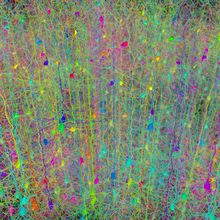In silico

In
History
The earliest known use of the phrase was by
In silico has been used in white papers written to support the creation of bacterial genome programs by the Commission of the European Community. The first referenced paper where in silico appears was written by a French team in 1991.[4] The first referenced book chapter where in silico appears was written by Hans B. Sieburg in 1990 and presented during a Summer School on Complex Systems at the Santa Fe Institute.[5]
The phrase in silico originally applied only to computer simulations that modeled natural or laboratory processes (in all the natural sciences), and did not refer to calculations done by computer generically.
Drug discovery with virtual screening
In silico study in medicine is thought to have the potential to speed the rate of discovery while reducing the need for expensive lab work and clinical trials. One way to achieve this is by producing and screening drug candidates more effectively. In 2010, for example, using the protein docking algorithm EADock (see
As an example, the technique was utilized for a
Cell models
Efforts have been made to establish computer models of cellular behavior. For example, in 2007 researchers developed an in silico model of tuberculosis to aid in drug discovery, with the prime benefit of its being faster than real time simulated growth rates, allowing phenomena of interest to be observed in minutes rather than months.[9] More work can be found that focus on modeling a particular cellular process such as the growth cycle of Caulobacter crescentus.[10]
These efforts fall far short of an exact, fully predictive computer model of a cell's entire behavior. Limitations in the understanding of molecular dynamics and cell biology, as well as the absence of available computer processing power, force large simplifying assumptions that constrain the usefulness of present in silico cell models.
Genetics
Digital genetic sequences obtained from DNA sequencing may be stored in sequence databases, be analyzed (see Sequence analysis), be digitally altered or be used as templates for creating new actual DNA using artificial gene synthesis.
Other examples
In silico computer-based modeling technologies have also been applied in:
- Whole cell analysis of human celllines
- Discovery of potential cure for COVID-19.[11]
- Bioprocess development and optimization e.g. optimization of product yields
- Simulation of oncological clinical trials exploiting grid computing infrastructures, such as the European Grid Infrastructure, for improving the performance and effectiveness of the simulations.[12]
- Analysis, interpretation and visualization of heterologous data sets from various sources e.g. genome, transcriptome or proteome data
- Validation of taxonomic assignment steps in herbivore metagenomics study.[13]
- Protein design. One example is RosettaDesign, a software package under development and free for academic use.[14][15][16][17]
See also
- Virtual screening
- Computational biology
- Computational biomodeling
- Computer experiment
- Folding@home
- Cellular model
- Nonclinical studies
- Organ-on-a-chip
- In silico molecular design programs
- In silico medicine
- Dry lab
References
- ^ "Google Groups". groups.google.com. Retrieved 2020-01-05.
- ISBN 978-0-444-60009-7.
- ^ Miramontes P. (1992) Un modelo de autómata celular para la evolución de los ácidos nucleicos [A cellular automaton model for the evolution of nucleic acids]. PhD Thesis. UNAM.
- PMID 1784830
- ^ Sieburg, H.B. (1990), "Physiological Studies in silico", Studies in the Sciences of Complexity, 12: 321–342
- PMID 20055453
- ^ Ludwig Institute for Cancer Research (2010, February 4). New computational tool for cancer treatment. ScienceDaily. Retrieved February 12, 2010.
- .
- ^ University Of Surrey. June 25, 2007. In Silico Cell For TB Drug Discovery. ScienceDaily. Retrieved February 12, 2010.
- PMID 19680425.
- .
- S2CID 206429690.
- PMID 33971086.
- PMID 16845000
- PMID 12948494.
- PMID 16698546.
- PMID 17196978.
External links
- World Wide Words: In silico
- CADASTER Archived 2012-03-30 at the Seventh Framework Programme project aimed to develop in silico computational methods to minimize experimental tests for REACH Registration, Evaluation, Authorisation and Restriction of Chemicals
- In Silico Biology. Journal of Biological Systems Modeling and Simulation Archived 2020-10-21 at the Wayback Machine
- In Silico Pharmacology
